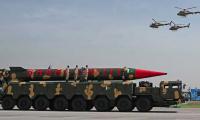ISLAMABAD: The government is seeking a way forward on the second phase of trade pact with China, a statement said on Tuesday, as it engaged trade bodies to address their concerns on the proposed deal.
The Ministry of Commerce held several sessions of consultations with representatives of small, medium and large industries to finalize its offer lists before next round of China Pakistan Free Trade Agreement (CPFTA) Phase II.
Such consultations have been held regularly before each round of bilateral negotiations on CPFTA.
“While generally agreeing with the offer framed by the Ministry of Commerce based on past consultations, the associations gave some additional recommendations for their respective sectors, which were accommodated,” a statement issued by the commerce ministry said.
“The industry was appreciative of the efforts of the Ministry of Commerce in trying to address their concerns in the Phase-II of China Pakistan Free Trade Agreement and making the entire process highly transparent.”
Pakistan has offered zero duty on almost 6,000 tariff lines out of the total 7,000 to neighboring China under the second phase of the Free Trade Agreement.
Several trade bodies sternly opposed the revised Free Trade Agreement with China, arguing that Pakistan does not possess exportable surplus so Islamabad’s exports could not get a boost in a big way even if it gets reciprocal incentives from China.
They said the offer might jeopardise major industries in Pakistan.
Pakistan’s imports from China increased from 18 percent to 28 percent of its global imports. Pakistan’s imports from China are 36 percent of Pakistan’s non-oil imports while China’s imports from Pakistan are 0.1 percent of the country’s global imports.
Pakistan’s imports from China are greater than 50 percent of global imports in 44 percent tariff lines.
China’s exports to Pakistan increased from $4 billion in 2006-07 to $14.56 billion in 2016-17.
Pakistan’s exports increased from $0.5 billion to $1.47 billion during the same period.
The maximum decline is registered in textiles led by cotton yarn which contributed 59 percent of decline in total exports.
In agriculture sector, oil-cake has registered the maximum decrease and contributed 9 percent of decline in total exports.
Following increase in investment-led imports Pakistan’s global trade deficit has increased to $30.9 billion in 2016-17.
The CPEC and infrastructure investment related balance of payment (BOP) outflows for Pakistan are expected to rise in the next several years, peaking at about $3.5–$4.5 billion by FY-2024/25.
With an investment of $9.5 billion under CPEC in 2016-17, imports increased by $5.51 billion.
If imports continue to rise in the same proportion with incoming CPEC investment, it is estimated to increase to $58.7 billion dollars in 2017-18.
The State Bank of Pakistan's old building in Karachi. — AFP/FileKARACHI: The State Bank of Pakistan has launched...
This undated file photo shows processed gold bars. — AFPKARACHI: Gold prices rose by Rs1,000 per tola on Wednesday...
A person holding a cattle. — Facebook@dalfapak/FileKARACHI: The fourth edition of the Dalfa Cattle Show will take...
US President-elect Donald Trump delivers remarks at Mar-a-Lago in Palm Beach, Florida, US, December 16, 2024. —...
Maria Pagan, US ambassador to the World Trade Organisation , attends an interview with Reuters in Geneva, Switzerland...
A construction in a multifamily and single family residential housing complex is shown in the Rancho Penasquitos...







